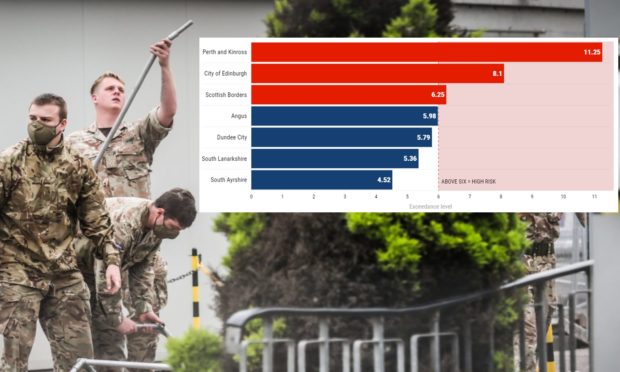The risk of local coronavirus transmission in Perth and Kinross has reduced slightly but remains the worst anywhere in Scotland, according to new figures.
The region has been dealing with a “significant” cluster of cases linked to the 2 Sisters food processing plant in Coupar Angus, which grew overnight on Thursday to include 157 factory workers and 20 community contacts.
An official report released weekly by the Scottish Government considers whether the current number of Covid-19 infections exceeds what health officials would expect at this stage of the epidemic, based on a modelling system from Warwick University.
Areas with an “exceedance level” above six are deemed to be at a higher risk of local transmission and may require “greater vigilance”, according to the report.
This week’s report, which covers the seven days up August 24, found exceedance in Perth and Kinross had fallen from 12.7 to 11.25, while Dundee reduced from 7.7 to 5.79. Angus saw an increase from 4.3 to 4.52 during the period.
Aberdeen, which came in at 3.6 last week as it dealt with the tail end of a major cluster linked to pubs and bars in the city, dropped out of the list entirely.
The city council’s co-leader Douglas Lumsden described last week’s findings, which showed the exceedance level in Perth and Kinross was more than three times higher Aberdeen’s, as “remarkable”.
Mr Lumsden and his co-leader Jenny Laing had pressed Nicola Sturgeon to lift local lockdown restrictions in the city from August 22 but was overruled by the first minister.
The Scottish Government later announced a number of measures would be lifted from August 24, bringing Aberdeen “broadly in line with the rest of Scotland”.
Restaurants, pubs, casinos and other such premises were able to open from Wednesday, after environmental health checks were completed.
This graphic in today's @pressjournal is remarkable. The local health experts recommended the cafes and restaurants should be open today, they were ignored. Seems strange that our levels are below others but we are in lockdown. pic.twitter.com/E8MlaaFcaw
— Douglas Lumsden (@dlumsden) August 22, 2020
The latest figures also reflected a worsening picture in a number of other local authority areas across Scotland, with Edinburgh, at 8.1, and the Scottish Borders, at 6.25, surging beyond the threshold for the first time.
South Lanarkshire, at 5.36, and South Ayrshire, at 4.52, fell just below the limit.
The new exceedance method is designed to be more robust than the R number – the average number of people infected by each person – because this figure can be volatile when the overall number of deaths is low.
The Scottish Government’s latest modelling appears to show the R number has stayed the same, with most recent estimates suggesting it is between 0.8 and 1.2.
The transmission rate being below one was previously seen as a critical factor for easing lockdown restrictions because scientists believe any higher number could indicate the virus is spreading exponentially.
The growth rate for Scotland is estimated to be between -7% and 1%, while new daily infections are estimated to be between 0 and seven per 100,000 people.
